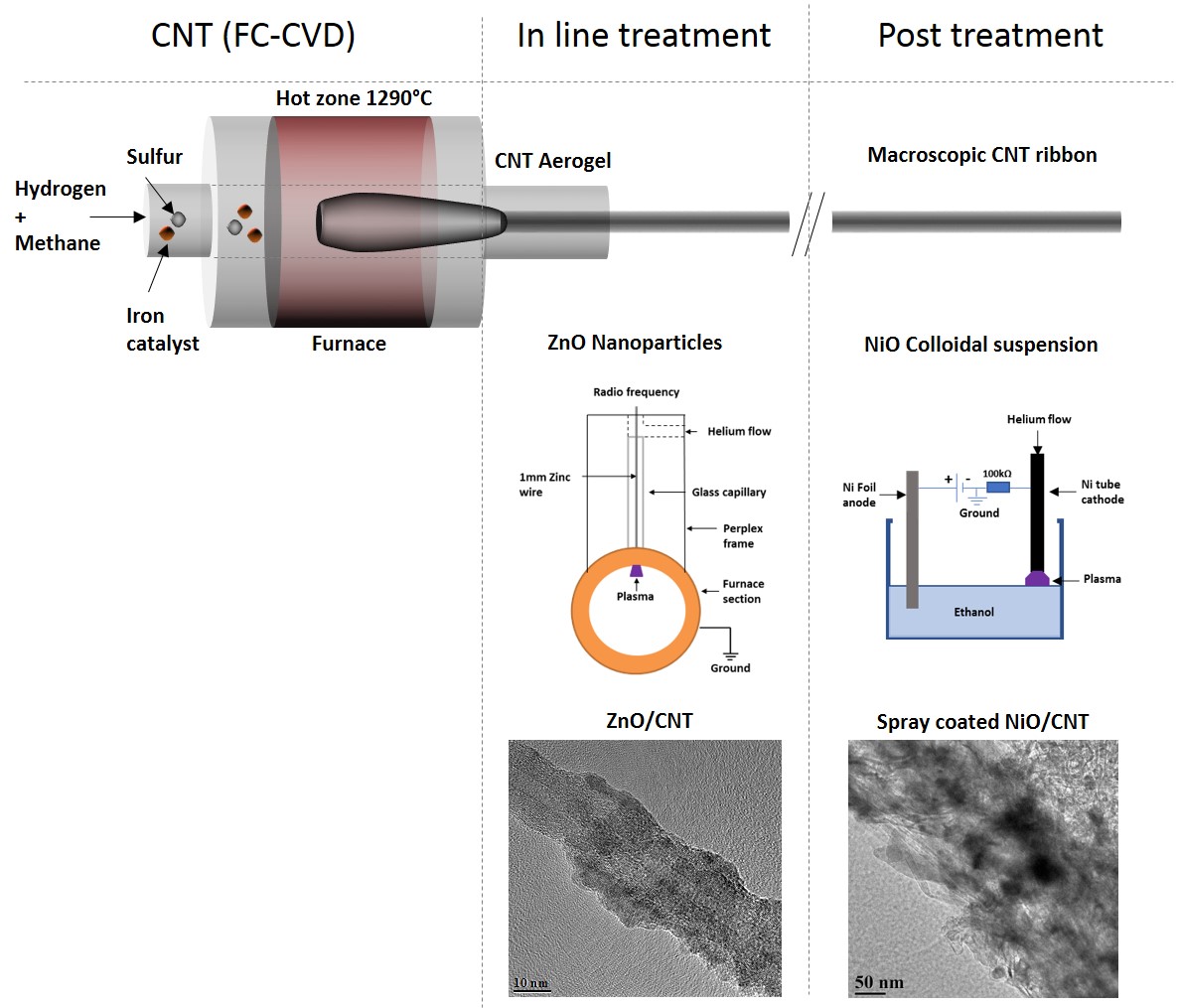Abstract
Carbon nanotubes (CNTs) have attracted a lot of attention due to their unique electrical, thermal and mechanical properties [1-3]. CNTs are also highly suitable to achieve multi-functional materials when combined with a range of nanoparticles (NPs)[4-6].
In this work, CNT macroscopic ribbon structures are synthesized using the floating catalyst chemical vapor deposition (FC-CVD) approach, using Iron as a catalyst, sulfur to limit the iron growth and to enhance the growth rate of the CNTs and methane as a carbon precursor [7].
Plasma-induced non-equilibrium electrochemistry (PiNE) was then used to synthesize NiO QDs and subsequently spray coated them onto CNT ribbons. The PiNE process used a Ni foil as the anode and a nickel tube as the cathode powered by direct current supply (45 min, 2 kV, 5mA). The NiO QDs exhibited a diameter of 3nm and were spray coated onto the CNTs which had been pre-treated with HNO3 to remove the Fe catalysts. The CNT-NiO QDs composite were tested for H2 generation with promising results.
As the two-step process highlighted limitations in the NP loading, a second approach was devised, developed and tested for high loading with Zn-based NPs. An RF helium microplasma reactor was integrated in-line with the CNT synthesis set-up to produce CNT-NPs in one-step process. Transmission and scanning electron microscopy confirmed the presence of ZnO NPs with a good coverage of the CNT ribbons. X-ray photoelectron spectroscopy shows that up to 40% of Zn can be loaded on the CNT ribbons, which represents a substantial improvement towards energy storage applications.
References
1. Ebbesen, T.W., et al., Electrical conductivity of individual carbon nanotubes. Nature, 1996. 382(6586): p. 54-56.
2. Kim, P., et al., Thermal Transport Measurements of Individual Multiwalled Nanotubes. Physical Review Letters, 2001. 87(21): p. 215502.
3. Baughman, R.H., A.A. Zakhidov, and W.A. de Heer, Carbon Nanotubes--the Route Toward Applications. Science, 2002. 297(5582): p. 787.
4. Qiu, L., et al., Enhancing the interfacial interaction of carbon nanotubes fibers by Au nanoparticles with improved performance of the electrical and thermal conductivity. Carbon, 2019. 141: p. 497-505.
5. Chaudhary, D., et al., ZnO nanoparticles decorated multi-walled carbon nanotubes for enhanced photocatalytic and photoelectrochemical water splitting. Journal of Photochemistry and Photobiology a-Chemistry, 2018. 351: p. 154-161.
6. Roy, A., et al., NiO-CNT composite for high performance supercapacitor electrode and oxygen evolution reaction. Electrochimica Acta, 2018. 283: p. 327-337.
7. Hoecker, C., et al., The Dependence of CNT Aerogel Synthesis on Sulfur-driven Catalyst Nucleation Processes and a Critical Catalyst Particle Mass Concentration. Scientific Reports, 2017. 7(1): p. 14519.

Figure 1
